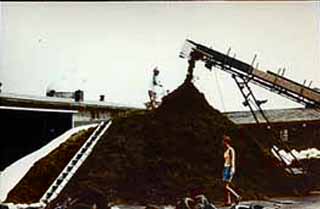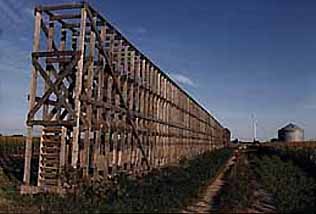Saving Energy
Primary agricultural production accounts for only 3.1% of the total fossil fuel energy used in the United States and 4.6 % of the total used in the United Kingdom. And this small proportion of the total fossil fuel energy used by these nations has been responsible for the great increases in agricultural productivity which have enabled the growing populations of the developed countries to be adequately fed. To continue to be highly productive, agriculture cannot economize on fossil fuels. However, there are still opportunities for energy savings in agricultural production.
Crop protection
Pesticides are commonly derived from refined petroleum products, and their use can be decreased by the development and application of control methods which provide maximum protection with minimum possibility of harm to the consumer or the environment. Fortunately, great progress has been made in this direction with integrated pest management (IPM) techniques (refer to pesticides section) and it can now be observed that there is a net tendency to use pesticides only when it is absolutely necessary.
Fertilizers
Below: manure
is carried out of a barn and then dumped by a conveyer belt.
Two possibilities exist for economizing on synthetic fertilizers, and thus on energy use, and these are green manures and animal manure.
Green manures consist of growing leguminous plants - which can 'fix' nitrogen from the air and convert it into a form which can be used by other plants - in rotation with crops, and then plowing them into the ground afterwards (instead of harvesting the plants as a crop.) Planting clover in the fall and plowing it in 1 year later adds about 170 kg of nitrogen per ha to the soil. In some cases, legumes can be planted in between the crop rows in summer and plowed under the following spring. Thus interplanting of corn with winter vetch in August and plowing it under in April adds about 150 kg of nitrogen per ha to the soil On the face of it, green manures offer possibilities for considerable savings since the amount of energy needed for planting the legumes would be about 0.93 GJ/ha, whereas synthetic production of 150 kg of nitrogen requires 12.2 GJ (Green, 1978).
The other alternative of using animal manure is also an attractive means of saving fossil fuel energy because, unlike green manure, it does not involve the utilization of additional land. One cow, nine hogs, or eighty-four chickens produce 10 tonnes of manure in a year, which provides 50 kg of nitrogen. Corn, for example, needs 125 kg of nitrogen per ha, therefore 25 tonnes of animal manure. To haul and spread this amount of manure over a radius of 1 km requires 4.1 GJ of energy while it takes 10.5 GJ to produce and apply 125 kg/ha of nitrogen as synthetic fertilizer(Green, 1978).
But this example, even though it shows a saving in energy, can be misleading since it completely ignores the economics: hauling and spreading 25 tonnes of animal manure per ha, especially as farms get larger and more spread out, is less efficient and effective when 500 kg of clean, easy-to-handle chemical fertilizer can be applied to do the same job! The technical problems of collecting, storing, and distributing manure on a large scale need to be resolved before manure will start to look more attractive to the farmer. Nevertheless, farmers should be encouraged to think about effective use of animal manures and assisted in storing them properly.
Machinery
Tractors and other mechanical equipment are major users of fossil fuel energy in agriculture and constitute considerable energy inputs while looking at energy efficiency. Of course, there is scope for improvements in design, particularly to produce implements which are more versatile, which are precision scaled for the job they have to do, and which operate at the most efficient speeds. Equipment could also make more economical use of energy-rich materials such as fertilizers and pesticides by placing them more accurately in the correct amounts (broadcast versus banded applications.) Finally, present methods of harvesting and transport, which use substantial amounts of energy, could be improved.
Crop drying
Below: a corn crib
stands ready for harvest, when it will be filled with corn cobs.
The drying of crops consumes a significant amount of fossil fuel energy, so natural drying methods should be used whenever practicable. Drying grains at high temperatures uses much more energy than the production of silage or field-dried hay, which makes use of the sun's natural energy, or grain in cribs which are dried by the wind. Natural drying methods take longer, however, and the crop is sometimes of a lower quality than artificially dried ones.
-In many developing countries, drying is done using solar energy. Some prototypes (put picture of solar dryers I gave you) were developed by the Brace Research Institute of McGill University and are now used in various parts of the world to dry various crops in an efficient and cheap manner.
Animal feedstuffs
The populations of developed countries have become accustomed to a substantial proportion of meat in their diets. Animals can be raised on grassland, rangeland and rough pasture that cannot produce any other kind of useful foods, but since the meat requirements of the population cannot be met entirely in this way, intensive animal and poultry production on confined feedlots has been developed on a large scale. This type of operation is responsible for a very large proportion of the fossil fuel energy used in primary agriculture in developed countries.About twenty years ago, there was a considerable movement to find alternative feedstuffs for animals which would reduce the large fossil fuel requirements of current animal production. One technique was to use animal excrement and by-products from slaughter as animal food to recycle the food through the animal. But as problems of buildup and transmission of drug residues and pathogenic disease organisms have started to grow (ex. bovine spongiform encephalopathy (BSE), the techniques have been questioned and many are now banned.
Today, one possibility to save on animal feedstuffs is to upgrade the nutritive value of straw (3.5 tonnes are produced for every ha of small-grain cereals grown). Considerable progress has been made already but it is not considered to be an economical solution yet. Forestry products such as sawdust and waste paper could also be processed to provide animal food, although ink and chemicals used in the manufacture of paper have to be removed. All such materials tend to be low in nitrogen, so they would need to be enriched with synthetic sources, thus reducing energy savings.
Protein for animal feedstuffs could also be produced on an industrial scale through the culture of microorganisms on chemical feed stocks such as hydrocarbons or methanol. The technology has been developed but it is not yet economical in energy terms because it takes about 180 MJ of fossil fuel energy to produce 1 kg of protein in this way, compared with about 65 MJ per kg of protein from corn or barley (Green, 1978). However, it does economize on use of land and other production costs.